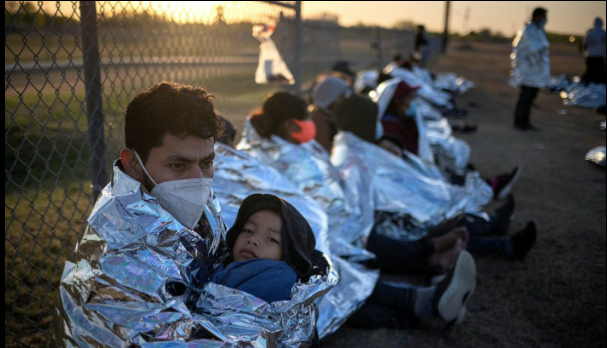Common Occurrence Exacerbated By Unprecedented Circumstances: Surge In Migrants Along Southern Border Tests U.S. Immigration Policy

Image Courtesy of Council On Foreign Relations
By Justin Lamoureux
President Biden recently scored a major political victory when Congress passed his COVID-19 relief bill: The American Rescue Plan Act. However, the vanity of such a development would be short-lived: along the southern border, a large exodus of undocumented migrants – including many unaccompanied minors – has presented a unique (and highly challenging) dilemma that puts his administration to the test.
Members of the Biden administration sought to improve their knowledge regarding the situation through a recent visit to the southern border. The delegation – which was headed by Department of Homeland Security (DHS) Secretary Alejandro Mayorkas and included Biden’s domestic policy advisor, Susan Rice – visited a border patrol facility and a refugee resettlement facility. The group was dispatched south two weeks ago by President Biden following an influx of border crossings by unaccompanied minors. While the visit was not followed by swift action from the administration, Secretary Mayorkas did provide some clarity regarding the administration’s approach during a recent interview on Meet The Press. He affirmed that “the border is closed” to all migrants, and while the administration has opted to continue expelling families and single adults, “we will not expel young, vulnerable children.”
That decision may prove consequential. In recent weeks, the number of undocumented children in Border Patrol custody has grown exponentially; the most recent figure is estimated to be around 3,500 children. Many of these youth were not accompanied by their parents or other adult relatives. It should be noted, however, that officials’ primary concern does not relate to statistics; providing sufficient accommodations to those in custody poses an even greater challenge. With shelter beds in minimal supply, the overwhelming majority of new arrivals find themselves living in detention cells designed for adults. This ordeal lasts an average of 108 hours – well beyond the 72-hour limit designated by law. It was recently reported that, while Biden administration officials were working to expedite the release of children to parents (or other relatives already living in the U.S.), they had only increased their shelter capacity by 200 beds.
The Biden administration has been working to understand the motivation behind this surge in migration and rebuild the U.S. asylum system following years of increased restrictions. In addition, while they are working to expand the current shelter network, officials are struggling to do so efficiently as most sites require approval from state regulators. The administration has not proposed new enforcement measures, either. President Biden has pleaded with prospective migrants not to cross the border, stressing that government officials “are in the process of getting set up.”
Despite taking a seemingly firm approach when addressing asylum seekers directly, the President has unveiled a sweeping immigration bill to create more lenient requirements for obtaining legal status. This plan includes an eight-year pathway to citizenship for nearly 11 million undocumented immigrants. In addition, the House of Representatives voted on two bills this week, to create shorter processes to attaining legal status for agricultural workers and “Dreamers” (undocumented immigrants who came to the U.S. as young children). While such legislation passed the Democratic-controlled House by a vote of 228-197 (with nine Republicans joining Democrats in support), it could face longer odds in the evenly-divided Senate.
Biden’s approach to immigration has attracted criticism from lawmakers on both sides of the aisle. Many Democrats have argued that his warnings to migrants not to cross the border are ineffective and offer little in the way of concrete solutions. Meanwhile, Republicans have slammed Biden for encouraging the uptick in border crossings, labeling the situation a “crisis.” Immigration activists have posited that unaccompanied minor children are spending too much time in detention centers when they should be released to await consideration of their asylum applications.
Media coverage of the situation has been equally scathing. NBC correspondent Jacob Soboroff recently visited Tijuana, Mexico, where he recorded telling on-the-ground footage of the scene. Heavy crowds at the border, parks lined with tents (where migrants live until they cross the border), and mothers cradling exhausted babies, constitute only a handful of the scenes he documented. In a video posted to Twitter, Soboroff attributed the recent influx of migrants to the economic fallout caused by the COVID-19 pandemic in a number of countries. He also emphasized that the Biden administration is capitalizing on many of the strategies employed by their predecessors, including mass deportations.
A recent CNN article posits that perception of instant shifts in U.S. immigrant policy (since Biden took office) has played a role in the recent surge in migration. A recent series of natural disasters is another factor; Soboroff noted that a substantial number of Haitian refugees, mostly victims of the devastating 2010 earthquake, could be found at the southern border.
The U.S. is no stranger to overwhelming numbers of refugees at the southern border. In 2019, the Trump administration dealt with a predicament that placed a comparable strain on facilities. Granted, the unique circumstances of the pandemic make it difficult to draw parallels between today’s arrests and those made in recent years. Nonetheless, by drawing parallels between this and past instances of increased migration, one can better understand the gravity of the current situation.
In January 2019 – the last year where a significant uptick in border crossings occurred – the Border Patrol reported encounters with 5,100 unaccompanied minors. Two years later, this past January, they took 5,700 children into custody. A former Health and Human Services official stressed that, generally speaking, the winter months see a drop in the number of migrants entering the country; the fact that numbers are so high in January and February makes the current influx even less typical. Numbers may also be higher on account of recent policy changes; the Trump administration fostered the development of policies that allowed for the instant deportation of unaccompanied minors. Conversely, the Biden administration has announced they will not adhere to this practice.
Changes to the conditions in which undocumented children are kept can be attributed largely to concerns about COVID-19 spreading through overcrowded shelters and social distancing guidelines. The Biden administration recently directed HHS shelters to begin operating at pre-pandemic levels, though, citing “extraordinary circumstances.” Health & Human Services is also considering a request to use Fort Lee – a military base in Virginia – for the purpose of housing migrants. This would provide shelters with relief, and prevent severe overcrowding. The Pentagon has provided housing for undocumented migrants twice before: In 2012 and 2017 (under the Obama and Trump administrations, respectively).
There has been a lot of discussion surrounding the situation on the border recently, from both the news media and on social media platforms. That being said, ensuring clarity regarding the nature of these circumstances is crucial. This is the task currently facing the Biden administration and relevant federal agencies. A surge in migrants along the border is hardly uncommon, but these are not ordinary times to begin with; that contributes to the exigence of the current state of affairs. Moving forward, instances like this could have greater political ramifications. It is possible that immigration could become a more pressing issue, especially as the country moves closer to normalcy following the COVID-19 pandemic. While the situation could improve in the coming months, especially as social distancing requirements are eased, and adequate housing for minors becomes readily available, how the Biden administration addresses the current exodus will likely remain under the spotlight for much of his presidency. Not only does this provide Vice President Harris – who has been tapped by the administration to lead the official response – with a unique opportunity to emerge from the limelight, it could also evolve into a major talking point for Republican candidates going into upcoming elections.







